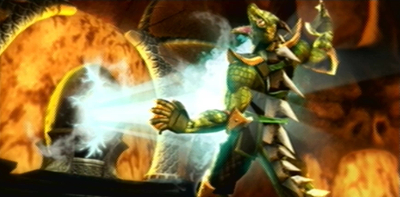
Mortal Kombat: Deadly Alliance revived the Mortal Kombat franchise, but it was still a game lost in time. Fighting games never truly went away (Tekken bore the burden of an entire genre longer than anyone would have ever expected from a game featuring a panda), but there’s a reason the Playstation 2 era of gaming is known for so many one-player experiences. You couldn’t heart a kingdom or cry up a devil with a buddy, and that was just fine by the public at large. The very concept of an arcade had withered and died, and online play was still a generation away from being stable on consoles (and never mind the internet connections available to most players). In short, multiplayer experiences in MK: DA’s generation were few and far between, and, while there were a few obvious outliers (come and join the Melee!), you couldn’t expect a 2-player fighting game to survive on the meager premise of humans competing.
Make no mistake, the following MK title, Mortal Kombat: Deception is a fighting game through and through. The producers looked at Mortal Kombat: Deadly Alliance, kept what worked (fighting styles, general gameplay, Kenshi), made some tweaks to the formula (added uppercuts across the board, dropped boring arena barriers for death traps, gave Raiden a new hat), and added a few fresh features to keep things interesting (combo breakers and the sensational kharacter find of 2004, Havik). MK: Deception is, of course, a new Mortal Kombat fighting game.
It’s also the game that includes Puzzle Kombat and Chess Kombat.
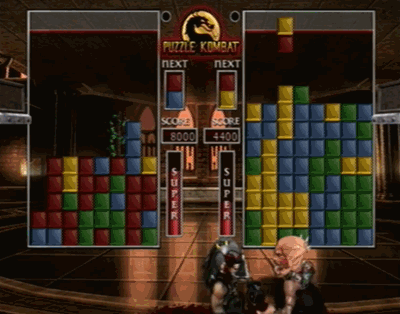
I’m not going to pretend to know what Mortal Kombat’s curators were thinking during the creation of Mortal Kombat: Deception, but it sure seems like the plan was “We’ve got one of the most popular IPs of the last decade, but it’s tied to a genre that is currently dead. Can we try… everything?” Thus, Mortal Kombat incidentally included a puzzle game. Thus, Mortal Kombat incidentally included a strategy game. And, thus, Mortal Kombat included an entire “adventure mode” that could have been a whole game onto itself.
“Konquest Mode” seems like a loose combination of two of the most popular genres of the PS2 era. On one hand, it’s basically a JRPG, seeing the player steer a chosen one through multiple towns and realms, on an epic quest where “random battles” are swapped for the occasional fighting match. On the other hand, it’s a Grand Theft Auto 3-style clone, with a huge, open world begging to be explored and maybe you can punch a random townsperson in the face for no reason. And, in PS2-era Mortal Kombat fashion, it’s in this mode that you unlock half of the roster and many of the alternate costumes (and other goodies), because you can’t spell “Mortal Kombat” without “You’re going to need a FAQ for these unlockables”.
But if you’re going to have an epic Konquest Mode, you’re going to need an epic story to go along with it. You’re going to need a battle between good and evil the likes of which the Mortal Kombat universe has never seen. You don’t need just a hero, you need the hero. And to match said hero, you’re going to need a villain so incredible, so immense, he’s apparently been hiding in the logo since the first Mortal Kombat tournament.
Ladies and gentlemen, meet Onaga, the Dragon King.
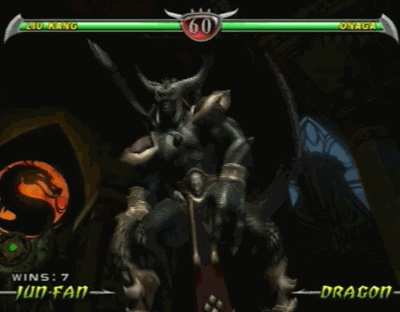
Now, to be clear, all of this kanon was retconned just in time for Mortal Kombat: Deception, but these changes have become “permanent” in the (mostly rebooted) Mortal Kombat universe, so let’s all just accept this story like it’s been there since Mortal Kombat 1. Remember Shao Kahn? The biggest bad of Mortal Kombat that has been a threat to Earthrealm again and again? Well, turns out Shao Kahn is clownshoes. In a time long forgotten, Shao Kahn was merely a minor deity of Outworld, and Onaga ruled the realm. We know it was eventually Shao Kahn that conquered Kitana/Sindel’s home realm of Edenia, but it turns out Onaga was the biggest bruiser in the realms, and many of the universes that were conquered and folded into Outworld were Onaga’s conquests. What’s more, Onaga is a literal dragon, and dragons in the MK universe are literally magic incarnate. As a result, Onaga could regenerate any damaged body parts, and, more importantly, he had the innate ability to revive literally anyone from death. So, Onaga had an army, and that army was literally immortal, because he could just CTRL+Z a bloody battlefield, and all his mans would be alive again. Onaga was an invincible warlord that played on Casual Mode and thus could not be stopped.
Well, until Shao Kahn poisoned him and stole all his stuff.
But Onaga had foreseen that being the most hated person in the universe might lead to an untimely end. As such, he set up something of a contingency plan: the last dragon egg in existence could potentially revive a dead dragon man, so Onaga got a cult together to protect said egg in a lava cave (Shao Kahn famously hates diving in lava [it’s bad for his skin]). Additionally, said cult mummified the Dragon King’s entire army, freeze-dried ‘em in a hidden temple, and basically kept the Dragon King’s seat warm for a few centuries. Onaga was coming back to menace the realms once more, it was just a matter of when…
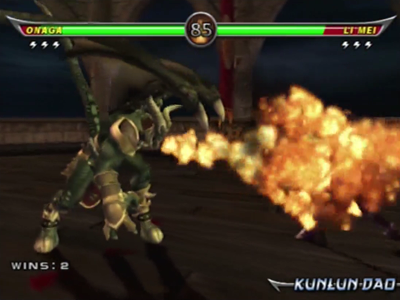
And when Onaga did return, he would be more powerful than ever (yes, even more powerful than an already unstoppable reptile that can revive the dead). Onaga had learned of the Kamidogu, six (or seven) mystical trinkets that existed in the six main (i.e. plot relevant) realms of the MK universe. If one were to collect all of the Kamidogu, they would be able to go Super Sonic summon Shenron go to the moon finally release Mega Man Legends 3 conquer the whole of the universe and become a god among gods. And, since death is more or less a general inconvenience in the Mortal Kombat universe, Dead-Onaga was now free to flutter about the realms and locate the Kamidogus. Spirit Onaga couldn’t physically do anything, but that could be easily rectified by finding the right kind of idiot to do his dirty work.
And that idiot is the protagonist of Mortal Kombat Deception and its Konquest Mode, Shujinko.
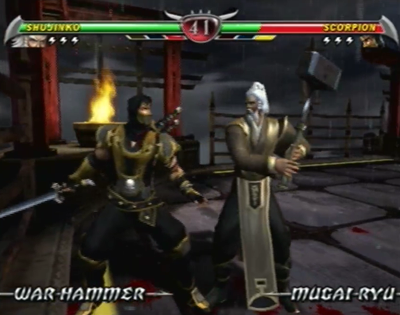
Wait, crap, I shouldn’t say “protagonist”, because Shujinko literally translates to “protagonist”. I should have saved that trivia/wordplay for later! Dammit!
Okay, as you can likely tell by the name, Shujinko was intended to be the “new” lead of the Mortal Kombat franchise. Liu Kang died last game, Kung Lao, Kitana, and Raiden bit it during the finale of Deadly Alliance, and MK was left without a hero. Shujinko was created to fill that spot, and be a true Mortal Kombat protagonist (dammit): the entire point of the story of Deception was that we would see how Shujinko was not the pure and unerringly good Liu Kang, he was a man that trained all his life to be a martial artist, and he meant to do good, but he was also tainted by a literal lifetime of making hard, “evil” choices in the name of what he believed to be a greater good. By the finale of Deception, Shujinko would be a champion appropriate for the dark Mortal Kombat universe: a man that has nearly brought the world to destruction thanks to his own pride, but one now trying to atone (with uppercuts).
Unfortunately, it didn’t work out quite that way, because the whole of Mortal Kombat: Deception makes Shujinko look like an idiot.
Which is fine! Shujinko is an idiot! Konquest Mode is a broad, sweeping story of the Mortal Kombat universe that starts when Shujinko is just an overeager boy anxious to be the next MK Champion, and it ends when Shujinko is old and gray (or white). In that time, Shujinko ventures across the realms, battles untold horrors, and learns the fighting styles of many different heroes and villains. But you know what he doesn’t do? Go to goddamn school. Shujinko has, at best, like a third grade education, and then he spends the rest of his life learning how to effectively punch skeletons. And, don’t get me wrong, it is great to know how to properly palm a skull after tearing out an opponent’s spine, but it’s not something that is going to impress college admissions (at most schools). And, of course, it’s not something that is going to teach you that you’ve spent literally your entire lifetime being deceived by a disembodied lizard king.
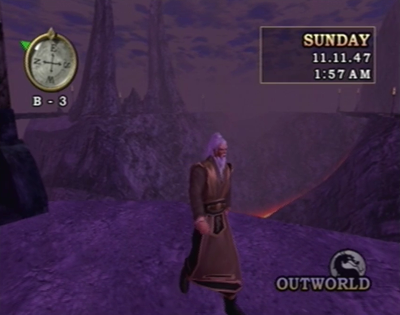
So here’s the soup to nuts story of Mortal Kombat: Deception: Konquest Mode. Shujinko was a young monk with big dreams and no other defining features. He lived in a small, pastoral village of other aspiring MK NPCs. One day, a spirit calling itself Damashi visited Shujinko, and claimed that Shujinko was now tasked by the very gods themselves to collect the Kamidogu of the six realms. To aid him in his quest, Shujinko was granted the magical ability to be able to instantly copy any special move that the programmers decided to grant him. Score. This also meant that Shujinko never really had to train or put any effort into anything. Double score!
Shujinko has a generally bad time on his quest. The whole thing kicks off with him being expelled from his idyllic community when he uses a mystical sword to battle a gigantic mantis. Or something. Then he winds up joining a group of assassins just so he can steal the kamiwhatsit of Earthrealm. Then he ventures through Chaos Realm and winds up stuck in some stupid hedge maze for like a decade. Then he literally goes to Hell, and you would think that would require years of therapy, but it just means he has to visit a friendly magical Native American to get his taint removed. And then there was some nonsense where he kinda started a war between Outworld, Edenia, and Order Realm, but it all worked out well (aside from the part where Shujinko spent many of his autumn years in jail). In the end, it wound up being a big, stupid quest that took nearly a century, about twenty game hours, and somehow involved literally every fighter that had ever appeared in Mortal Kombat up to that point (except the Chameleon/Khamelon twins, because we have enough lizards in this plot, thank you). Fun times for everybody! And Shujinko did wind up collecting the kamidoggies, so the Elder Gods are going to be so pleased when he shows up with…
Oh no! This whole quest where Shujinko repeatedly chose the darkest path available on a mission from “god” turns out to have been a ruse all along. Undeterred by the sheer number of orphanages that had to be burned down on his way to collecting magical objects of abject power, Shujinko never suspected that this whole adventure was a sham. A deception! There never was a “Damashi” at all, it was the Dragon King all along! And Dr. Robotnik is really trying to steal the Chaos Emeralds for himself! Who could have foreseen this eventuality!?
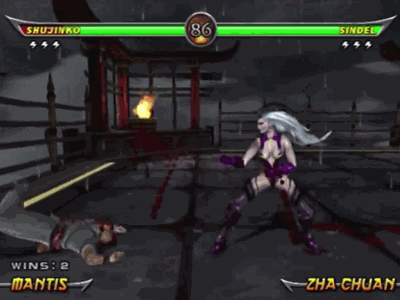
Shujinko hands the sacred items over to “Damashi”, who reveals himself as Onaga, and is all of five seconds away from turning Shujinko into Shujerky when -simultaneous action- Nitara revives the physical Dragon King by accidentally hatching the baby dragon egg and transferring Onaga’s spirit into Reptile’s body. Yes, I know that sounds kind of confusing, but that’s what happens when you weld the ending from one game onto the “new” story of the next game. So now Onaga is physically alive again (thanks to Nitara, not Shujinko), and he (I guess) walks over to where Shujinko stowed all the Kamidogus, grabs ‘em, and then decides to steal the secret seventh Kamidogu, which turns out to be Quan Chi/Shinnok’s amulet. Onaga stomps over to the Deadly Alliance, kills ‘em all (more or less), and kicks off Mortal Kombat Deception: Proper Arcade Mode wielding all seven god gems.
(And, just for funsies, he revives the good guys that were killed by the Deadly Alliance, and reboots his undead army with a few extra warriors. Quan Chi thought this was a great idea.)
So, with the Story Mode of MK: D done, the “real” story of MK: D is that Shujinko gathered all the dorks that he ran into during Konquest Mode, got them all in one loosely defined tournament, and then pulled off one actually smart move: Shujinko has the ability to absorb the powers (and soundbites) of fighters. If you got, like, every fighter all in one room, he could absorb the power of every fighter. So, basically, the tournament that is Mortal Kombat: Deception was all an excuse to power up Shujinko to the point that he could manifest some kind of glowy, rainbow fist, shatter the Kamidogu that were empowering Onaga (you can just… break divine objects?), and then literally punch the soul right out of Onaga’s body. This frees Reptile to just be Reptile again, and Shujinko is now the once and future protagonist of Mortal Kombat. He might have endangered the whole of existence, but at least he fixed it (eventually).
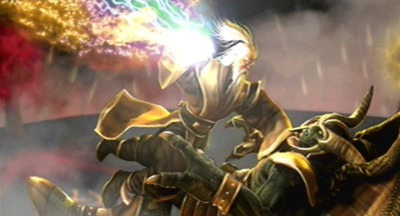
And what did our proud protagonist go on to do after his victory over his former patron? Well, Shujinko was still an idiot, so he got tossed in a dungeon by Mileena posing as Princess Kitana. Shujinko claimed that he was doing this to spy on Mileena and the revived Shao Kahn, but all evidence points to Shujinko absolutely not pulling off such a ruse. Shujinko was released in time for the final battle of MK: Armageddon, but, despite every warrior in history being there for the absorbin’, Shujinko still managed to bite it with everybody else. Shujinko was not to be revived for the rebooted universe (give or take a very out-of-character comic appearance), but he was killed in one ending from Mortal Kombat X, and was then again claimed to be killed by an entirely separate kharacter in Mortal Kombat 11. The message is clear: Shujinko is not the protagonist you are looking for.
And what of Onaga? Well, after his defeat, he was revived almost immediately by Shinnok. The “new” Onaga was now inhabiting his revived, “old” body, which was simultaneously a wonderful way to free up Reptile and explain why Onaga was now only super powerful, as opposed to godly powerful. Onaga fought with the official Forces of Evil at the battle of Armageddon… and died with everybody else. You’d think his magical reviving powers would have come in handy there, but, hey, guess his old body just wasn’t quite up to reviving shape. That’s one less cold-blooded emperor Edelgard has to worry about.
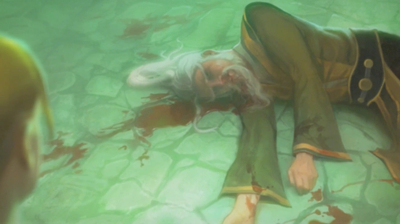
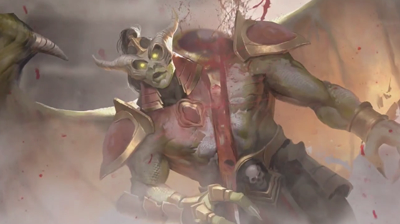
Nobody survives the reboot universe
Onaga is referenced repeatedly in the rebooted universe, but doesn’t actually make an appearance. The writers seem to be sowing some interesting plot beats with implications that Shao Kahn and Liu Kang are both using portions of Onaga’s legendary power (whether they know it or not), but the big guy hasn’t popped up yet. This makes sense, as Onaga’s revival was only thanks to basically the accidents of Shujinko and Nitara doing exactly what they were supposed to do exactly when they were supposed to do it, and asking for Shujinko to be successful in two different universes stretches credibility a bit much. Presumably, Onaga is still sleeping under the hill, waiting for the time of Mortal Kombat’s greatest need.
And if anyone else from Mortal Kombat: Deception shows up in future MK games, you know the franchise is in desperate need…
Next time: I will give you $20 if you can tell me who Dairou and Darrius are right now. (offer void in Earthrealm)

[…] she comes off as a little lacking compared to the likes of unstoppable foes like Shao Kahn or that immortal dragon dude. She’s a mage in barbarian world, and Skeletor is definitely more fondly remembered than […]